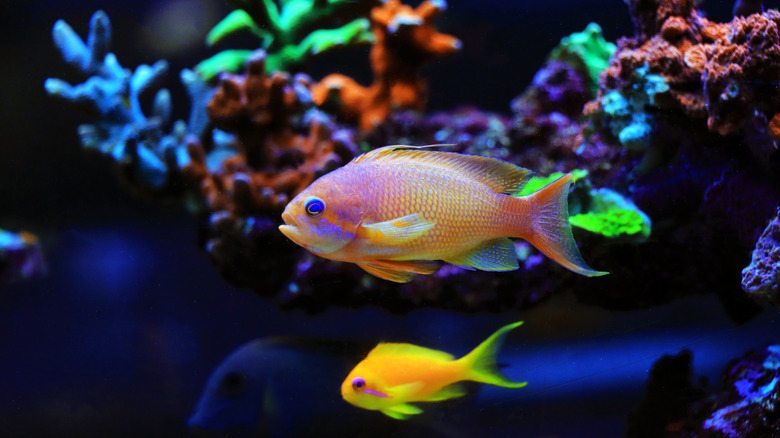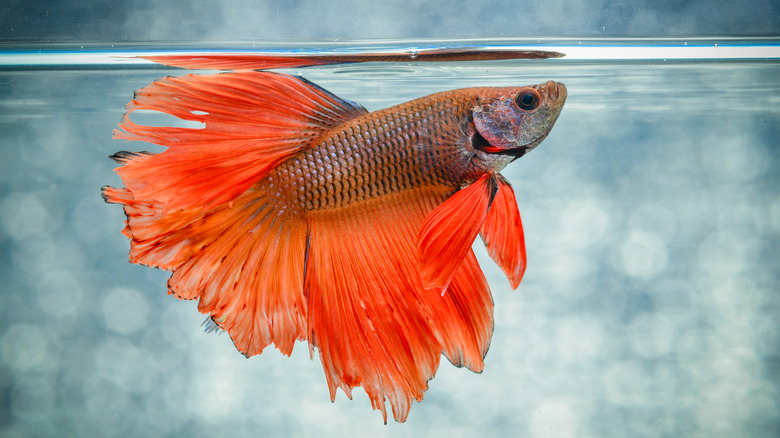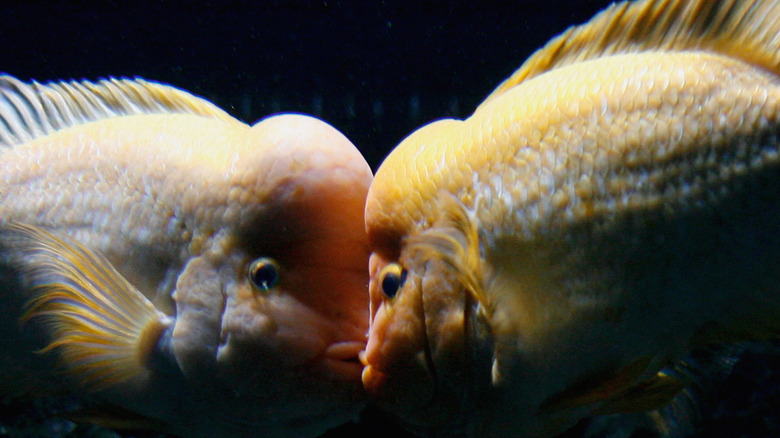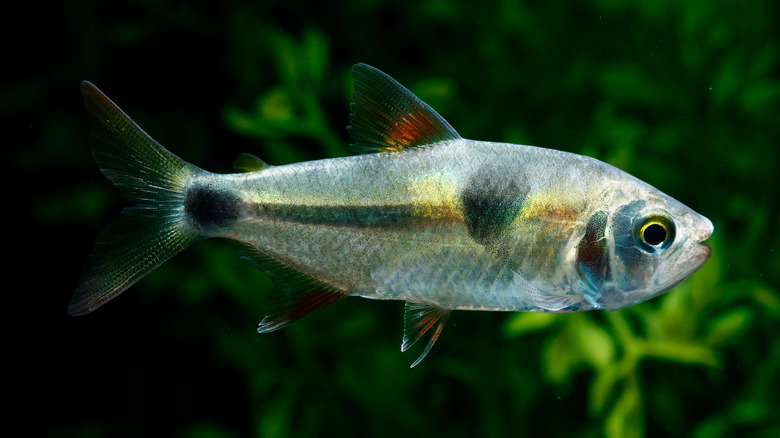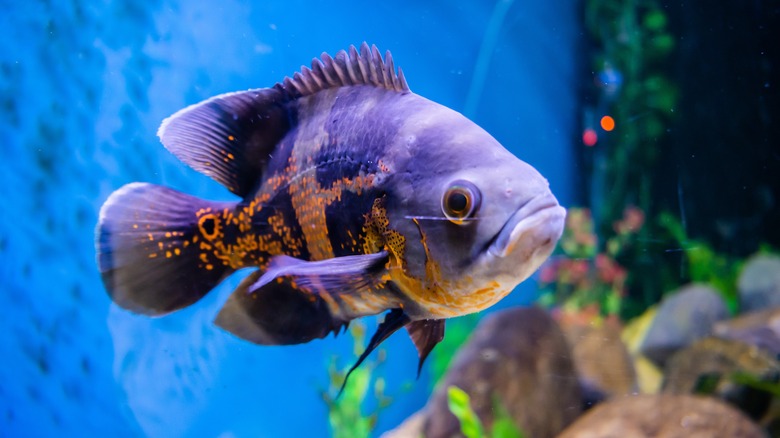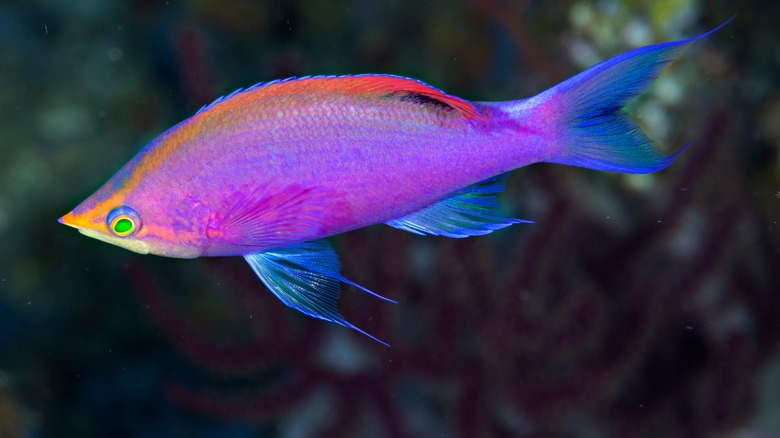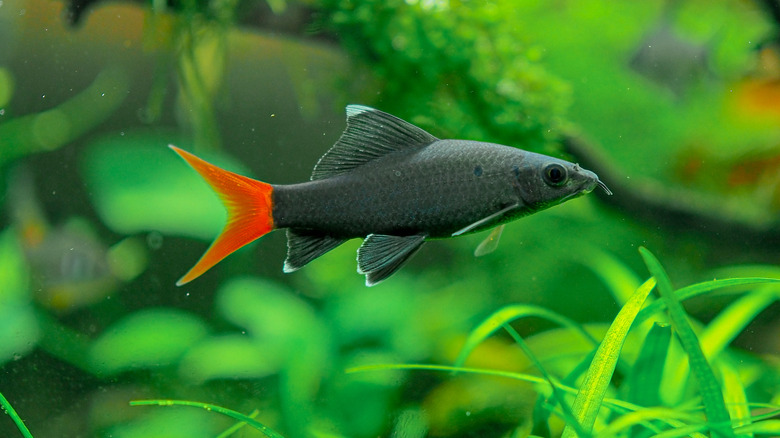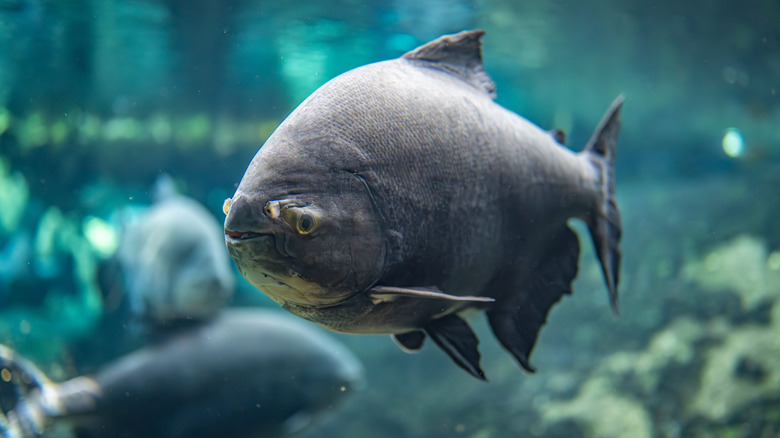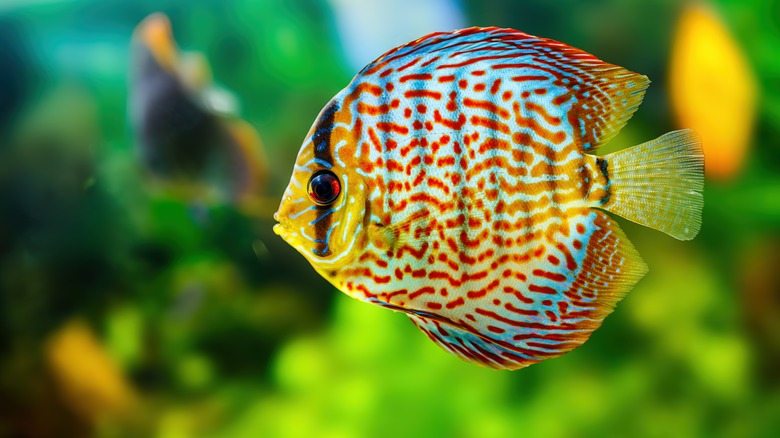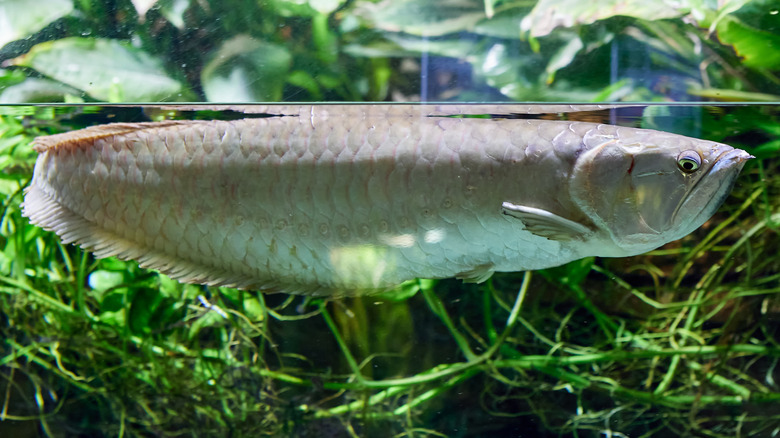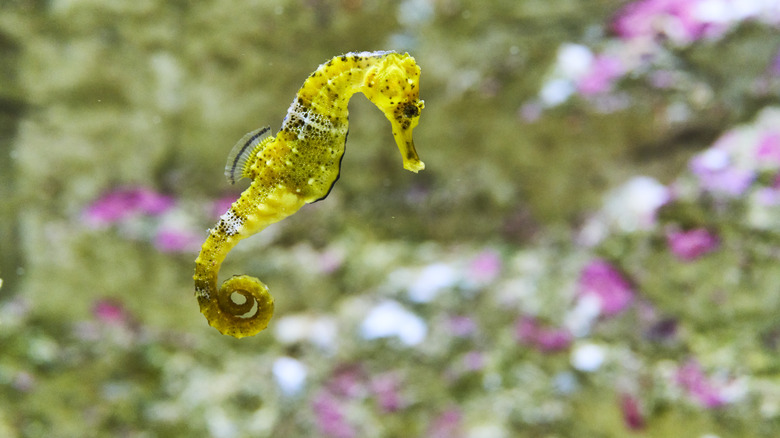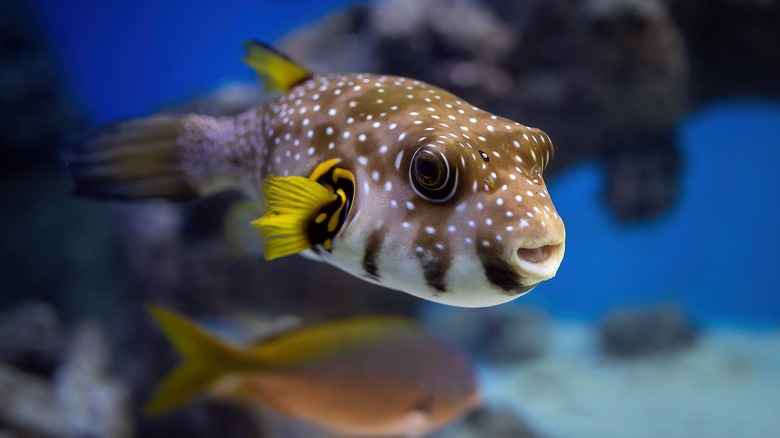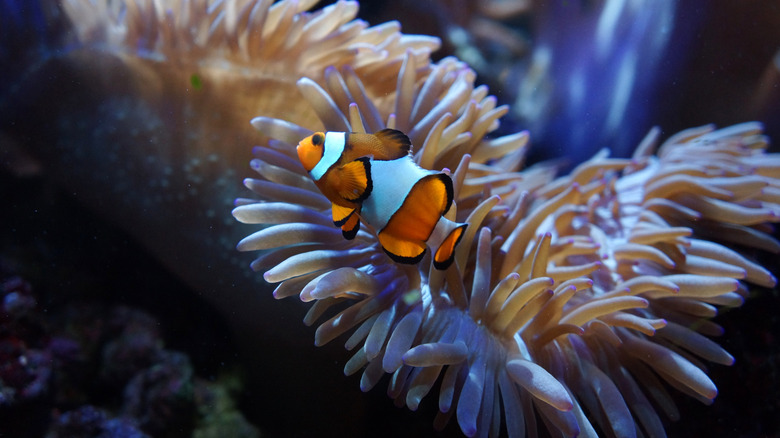Fish You Should Think Twice About Before Adding To Your Aquarium
Choosing fish for an aquarium is like choosing roommates: Just because they look good together doesn't mean they'll enjoy sharing the same space. Instead, as with people, matching the right fish starts with choosing "roomies" that have compatible personalities and living needs.
Much as you wouldn't want to match your bestie who always leaves their dishes in the sink with a militant, neat-freak roommate, you wouldn't want to place aggressive fish with meek ones they're likely to bully. And just as you wouldn't cram a family of four, including small children and pets, into a tiny home and expect them to create a tranquil environment, you shouldn't put fish that need a lot of space into a too-small aquarium. Chaos, aggression, or an unhealthy living environment inevitably result.
With that in mind, you might want to reconsider adding the following fish to your aquarium. From requiring room to stake out personal territory and having aggressive personalities to growing so large that they take up far more space than you might expect, these fish have more complex and challenging needs than the casual fishkeeper may be prepared for. That doesn't mean you should never keep these species — but you do need to make sure you fully understand their care requirements and are prepared to meet them.
The fighting betta
Few fish are more iconic than the flashy male betta; you'll find them in almost every pet store, floating in bowls that are far too small for their long-term needs. Although that bowl size is an issue, there's a reason male bettas are almost always housed individually: They're so aggressive that they were used in staged fights in 18th and 19th century Thailand, earning them the nickname "Siamese fighting fish." Female bettas may be less likely to try and fight fish in entirely different tanks than the males, but female are still at the aggressive end of the spectrum. Given their popularity, bettas can surprise inexperienced fishkeepers with their needs.
Much like the males, the key to keeping female bettas is space: Even female bettas need a large amount, along with lots of nooks and crannies they can use to hide and separate themselves from other fish. Pinning down exactly how much space they need isn't an exact science, but PetMD recommends a minimum of a 15-gallon tank for a sorority of female bettas. In the journal Comparative Medicine, researchers who kept bettas reported that they often preferred to house female bettas separately, as they did with the males. However, if they did co-house females together, monitoring for — and removing — unusually aggressive individuals was key to success.
Once you have the betta's space and hiding needs nailed down, there are still a few things you should be aware of. Both male and female bettas are carnivorous and tend to bloat if you feed them typical tropical fish food pellets, so you'll need to make sure they eat high-protein foods instead. They may also eat smaller fish in your tank. Lastly, all bettas need access to the surface of the water, because they breathe by gulping air there.
Cichlid
The behaviors of the relatively hardy, charismatic, and often fast-growing cichlid can be fascinating to watch. But they're also notoriously challenging to keep thanks to their unpredictable (and frequently rampant) aggressiveness. While there are some tricks you can try to decrease this fish's willingness to fight, there is no one-size-fits-all solution. Some cichlids do better with more fish in the tank, others thrive in a more lightly stocked environment, and some just can't mind their manners in a mixed-sex situation.
If you're planning on keeping cichlids, success starts with careful research into exactly which species you're thinking of getting and what they need to thrive. That's no small task, as there are hundreds of different African and South American cichlid species that may be kept in aquariums. And their needs are sometimes counterintuitive: For example, unlike other aggressive fish that require a lot of space per fish so they can stake out individual territories, many cichlid species tend to do well when living en masse with other cichlids.
Every fish's personality and behaviors will be different, though, and it's smart to have a plan B for what to do with any bullies that emerge from your cichlid crowd and end up needing to be removed from the tank. You should also pay close attention to what your prospective cichlids eat. Some cichlid species need a diet that is very high in protein, while others do not.
Bucktooth tetra
The bucktooth tetra, sometimes referred to as the Exodon tetra thanks to their scientific name Exodon paradoxus, may not get very big — but they can be so boldly aggressive that even much larger cichlids hide from them. While it is fascinating to watch these flashy, active fish swarm any bits of food you drop into their aquarium, it can be downright disquieting to see them pursue their usual "hunting" behavior: swimming straight into other fish and using their specially evolved "buck" teeth to tear away scales, which then become lunch.
Exodon tetras generally do well in shoals if you give them plenty of space, but there aren't many fish they can live with. The Exodon is so active in patrolling its tank that a shoal of a dozen fish generally needs at least 55 gallons of room, per PetMeDaily. But what kind of "roommate" can live with a tetra fish that can be up to 6 inches long and has seemingly no fear of attacking much larger, heavier fish? Not many, aside from maybe armored catfish like the plecostomus that did well with one author's aggressive bucktooth tetras, as published in Tropical Fish Magazine. Unfortunately, plecostomus pose their own problems.
Oscar
The charismatic oscar is actually a type of South American cichlid, so it's really not a surprise that they're voracious feeders who can see anything else in the tank with them — including other fish — as a potential meal. These fish aren't just perpetually hungry (and maybe a little bit hangry, too); they're also very large and messy, requiring a lot of space and a serious plan for keeping the tank clean.
Oscars are also full of personality, so it's easy to understand why so many people fall in love with them. But all that personality means they can be unpredictable. While many an oscar will recognize their human caretaker and be happy to see them coming around feeding time, they might also take a few bites out of their fingers if they put their hand in the water. Additionally, your oscar might entertain itself by jumping out of the tank, so a tightly-fitting lid is a must, as is an aquarium with lots of swimming space and oscar-safe features like gravel and decorations without sharp edges that your oscar can rearrange at will.
Anthias
There's something magical about having a brightly colored shoal of anthias flitting around your aquarium. But the many species of this fish can possess a bewildering variety of environmental needs — from maintaining relatively dark, cool water for deep-water species to providing calm, quiet tankmates if you're keeping a shy species like the ventralis anthias. Even Hermione Granger-levels of research prowess aren't enough on their own to keep these finicky fish happy; the successful anthias keeper must also be ready for problem solving on the fly.
One of the biggest challenges that comes with keeping anthias is their sky-high metabolism: They must be fed small amounts of food at least five times a day, according to Polo Reef. If you feed your anthias on the same once- or twice-a-day schedule that is fine for most other fish, they will starve. Automatic feeders are a natural solution for that problem, but some anthias are notoriously picky eaters, so you need to make sure they're actually eating what you offer. A few anthias species also have unusually small mouths — another obstacle to making sure they're getting enough food. Add in the intrigue of navigating individual fish personalities, and it becomes clear why so many advanced hobbyists see this fish as a beautiful challenge.
Red-tailed sharks
Despite their name and appearance, red-tailed sharks aren't actually sharks; they're in the carp family. However, these fish are often aggressive to the point of outright hostility, pestering and chasing other fish away from whatever territory they've claimed. Red-tailed sharks can be very territorial, too, so if you have ambitions of keeping more than one, you're going to need a very large aquarium.
Make sure the tank has a tight-fitting lid, as nearly every red-tailed shark owner has at least one story about how well these fish jump — sometimes to their end, if they manage to land outside the tank. Interestingly, some fishkeepers report that the red-tailed shark's general assertiveness can make them a good match for cichlids, as both species can hold their own against the other — if they're given enough space to do so.
Pacu
If you want all the menace and intrigue of a piranha with none of the flesh-shredding danger, you might find yourself considering a pacu. These fish look very much like piranhas, but prefer to eat vegetables. However, if kept in the right conditions, pacu can easily grow from just a couple inches to a foot in length within one year.
And that's just the start — they get even bigger. The largest red-belly pacu on record grew to be almost 3 feet long and weighed 55 pounds. All that growth doesn't happen overnight, though; that giant fish lived to be a whopping 30 years old.
Because this fish readily outstrips the capacity of almost any home aquarium, and could even outlive you depending on your age when you get the fish, you absolutely must have a long-term plan in place if you're thinking of keeping pacu. In the right climate, a large, year-round pond could be an option — but releasing them into wild waterways is both destructive to the environment and harmful to the fish, which in many cases is unlikely to survive.
Plecostomus
Once seen as the benign champion of many an algae-plagued fish tank, it's becoming common knowledge that the plecostomus has a little problem: It gets very big. Within about five years, that few-inches-long pleco you purchased can grow to be as much as 2 feet long.
What about creating a long-term care plan for your giant plecostomus? Not many people are set up to provide humane refuge to a fish that big, and releasing them into the wild isn't an option either. That either dooms your plecostomus to death, or dooms the local ecosystem to disruption. But there is hope: Instead of reflex-buying the common plecostomus that grows so large, look for some of the few species that stay small enough to live comfortably in aquariums, such as the bushy nose or bristlenose plecostomus.
Discus
Many fish need an aquarium with a large footprint or, to put it another way, lots of horizontal space so they have plenty of room to roam or separate themselves from their tankmates. That's true for the discus, which can require a tank of at least 75 gallons when fully grown, but they also need plenty of vertical space to accommodate their tall, elegant bodies, per Aqueon. Discus are also notoriously delicate, requiring a pristine tank environment, and may need warmer-than-usual water temperatures.
The discus also does best when living in schools. Recommendations for school size range anywhere from keeping at least six in a group to ten or 12, but the unquestioned consensus is that if at all possible, no discus should live alone. Lastly, discus need lots of nooks and crannies to duck into. In an aquarium, offering a mix of plants can help create a similar environmental feel.
Silver arowana
Much like oscars, the silver arowana is charismatic, interesting to watch, and a voracious feeder. But adult silver arowanas can easily reach 3 feet in length. Not only do they outstrip the capacity of almost any home aquarium but they do it very quickly, with juveniles capable of growing about 2 feet in their first year of life. So it's little surprise that PetMD recommends a bare minimum of 150 gallons for one adult.
It's also hard to find good tankmates for the silver arowana. Happily, most of them prefer to be alone — but if you're set on companion fish, you should choose species that are too large for the arowana to gulp down, and who prefer to swim along the bottom of the tank. Arowanas typically hang out near the top of the water, and dividing the tank up into high- and low-level swimmers is a classic way of reducing competition for limited territory.
Seahorses
It's no wonder that seahorses are such a common impulse buy: They're pretty much fairy tales come to life, with their tiny, fluttering fins, prehensile tails, and vaguely horse-like heads. Seahorses are also shockingly weak swimmers, so if you bring them home, they'll need lots of plants, ropes, and other sharp-edge-free decor in their tank that they can cling to with their tails. Clean, well-filtered water is another particular need for these fish.
In terms of personality, seahorses tend to be sweet and docile, and they generally do well when kept with other calm, gentle fish. But in some ways, those traits can be as challenging as keeping aggressive fish: Because they're such weak swimmers, seahorses won't be able to evade aggressive fish or outcompete fast-swimming species for food. So you must feed them frequently, preferably with live food, and pay attention to make sure they're actually getting enough to eat.
Pufferfish
The pufferfish is a complex creature: Smart enough to recognize individual humans and feed straight from your hand, but also prone to picky eating and unpredictable aggressiveness, sometimes to the point of hunting their tankmates. While some can happily cohabitate with the right "roommate" species, the resulting interactions can be unpredictable enough that you may want to default to keeping your puffers only with similar puffers, then consider adding other fish on a trial basis.
You'll need to do even more than the usual amount of new fish research with puffers (also called blowfish), in part because some species live in saltwater while others live in freshwater, and yet others may live in brackish water or even shift back and forth between environments. You should look into each species' personality, too: Some are known to change throughout their lifecycle, starting out affable to their tankmates but eventually maturing into the aquarium equivalent of a grouchy, isolated curmudgeon yelling at the other fish to get off their lawn.
Oh, and maybe you've heard of fugu or teppo, the Japanese delicacy of pufferfish that will kill you if it's been prepared incorrectly? Some of your pet pufferfish have the same tetrodotoxin in their skin and other body parts, and could even release it into the water. So hands off, and don't let your cat or dog drink from that aquarium.
Clownfish
Sorry, Nemo. Although hardy, the iconic clownfish is still a saltwater fish, and most beginners aren't prepared for the extra complexity of dealing with a saltwater aquarium. Clownfish can also live for up to 20 years or even longer — a much longer commitment than many new fishkeepers expect, given that most pet fish have average lifespans of just three to five years.
Clownfish will generally get along with other fish of similar size, but if you put too many clownfish together they're likely to start bullying each other. Generally it's best to keep your clownfish population down to just one or two, although, much like cichlids, the various species of clownfish can have quite different needs. Your clownfish-keeping journey should start with some research to determine whether the species you've chosen would be happiest on its own or with a potential mate. These fish can change their sex, one of three intriguing clownfish adaptations, so you generally don't need to worry about sexing a prospective aquarium addition — they'll figure that part out on their own.
